
Merit-Based Hiring Practices: Balancing Fairness and Representation
Merit is often described as a neutral, objective standard for hiring. But the way we define and measure merit is shaped by personal values, cultural norms, and access to opportunity.
In recruitment, this means a well-intentioned focus on "hiring the best" can sometimes ignore who’s been allowed to become their best.
This article explores how to design hiring systems that reflect both performance and inclusion: recognizing talent without overlooking the context that shaped it.
What Do We Mean by “Merit”?
At its core, merit refers to a person’s qualifications, skills, and readiness for a role. But even these terms can carry assumptions.
A polished résumé, for example, may reflect access to mentorship or stability more than raw ability.
Fluency in industry language may say more about background than potential.
When hiring teams don’t stop to question what they reward, they may unintentionally filter out high-potential candidates who didn’t follow traditional paths (Cohen & Garcia, 2008).
Why Merit-Based Systems Can Still Reinforce Bias
Merit-based hiring doesn’t exist in isolation. Every résumé a recruiter reads is shaped by years of access: or lack of it.
Who had internships in college? Who could afford unpaid opportunities? Who worked through school or supported family while building their career?
When these realities aren’t accounted for, hiring based on “neutral” standards can reward privilege while overlooking resilience, adaptability, or leadership in less formal settings (Rivera, 2015).
Balancing Performance and Representation
A stronger hiring system recognizes that representation and performance don’t compete.
In fact, diverse teams tend to outperform homogenous ones when given the same support and access (Hunt, Yee, Prince, & Dixon-Fyle, 2018).
To balance fairness and inclusion, companies can:
Define merit in job-specific terms, not general traits
Assess potential alongside experience
Offer structured rubrics to reduce gut-feel decisions
Focus on behavior-based interviews, not résumé filters
These shifts help hiring teams make decisions that are both grounded and expansive.
Common Myths About Fairness in Hiring
There’s a belief that including diversity goals somehow dilutes quality. But research consistently shows that removing bias improves decision-making, not the reverse (Bohnet, 2016).
Hiring isn’t about choosing between fairness and excellence: it’s about designing a process that lets both show up clearly.
Another myth is that being “blind” to identity creates equity. But ignoring race, gender, or disability doesn’t make bias disappear. It just makes it harder to see when it happens.
Redefining How You Evaluate Talent
Rethinking merit starts with the job description:
Are you screening for the role or for pedigree?
Are required degrees truly essential, or just customary?
Are interviewers aligned on what they’re measuring?
Clear definitions reduce ambiguity. When teams agree on what great performance looks like in a role, it becomes easier to spot in people from different backgrounds.
Structuring Your Hiring Process for Equity
Some practical strategies:
Use consistent interview questions across all candidates
Blind initial screening fields where possible (e.g., school, name)
Calibrate interviewers together before final decisions
Add diverse reviewers to reduce individual bias
Equity doesn’t mean every candidate is treated the same: it means each one is given a fair chance to be seen accurately.
Real-World Examples of Inclusive, Merit-Based Hiring
Companies like Gap Inc., Accenture, and EY have moved toward skill-based hiring. Rather than filtering by degree, they assess on-the-job capabilities through simulations and structured interviews (LinkedIn Talent Solutions, 2023).
Organizations such as Project Include and Paradigm also offer models for integrating inclusion into hiring without compromising clarity or standards.
Final Thoughts: Fair Doesn’t Mean Colorblind
Merit-based hiring works best when it acknowledges the full context of performance: not just the outcome, but the path it took to get there.
When hiring systems are designed to be thoughtful, consistent, and inclusive, companies don’t have to choose between fairness and representation.
They’re part of the same goal: recognizing talent in all its forms.
How Diversity.com Supports Inclusive Hiring
At Diversity.com, we know that inclusive hiring isn’t about lowering standards—it’s about raising the bar and removing outdated filters that limit potential.
That’s why we equip employers with the tools, strategies, and talent pipelines to build teams that are qualified, diverse, and forward-thinking—without compromising on excellence.
Whether you're refining your recruitment process, improving retention, or navigating new DEI challenges, we’re here to support your mission with real solutions and real results.
For Employers & HR Professionals:
✔ Create a free employer account — Start posting jobs that reflect your values. Choose from single listings, job packs (discounted credit bundles), or subscription plans tailored to your hiring needs.
✔ Access a diverse, top-tier candidates — Connect with professionals who bring both qualifications and fresh perspectives to your team.
✔ Stay informed with expert DEI insights — Learn how to apply inclusive strategies without sacrificing performance.
For Job Seekers:
✔ Explore inclusive career opportunities — Discover employers that care about merit, culture, and impact.
✔ Create a free job seeker account — Apply confidently for jobs with companies that believe in equity.
✔ Understand Inclusive Hiring — Learn how DEI really works—and how it can work for you.
We don’t lower standards. We eliminate the barriers that keep talent hidden.
Start building a better, bolder team today—with Diversity.com.
Questions? Contact Us, and we'll walk you through it.
Related Articles
What Is Employee Belonging? Build a Culture That Includes Everyone
Workplace Representation Strategy: A Guide for Inclusive Talent Teams
Bias-Free Job Descriptions: Write Inclusive, Effective Listings
Unconscious Bias Training for Recruiters: What Works and Why
Sources & References
Bohnet, I. (2016). What works: Gender equality by design. Harvard University Press.
Cohen, G. L., & Garcia, J. (2008). Identity, belonging, and achievement. Current Directions in Psychological Science, 17(6), 365–369. https://doi.org/10.1111/j.1467-8721.2008.00607.x
Hunt, V., Yee, L., Prince, S., & Dixon-Fyle, S. (2018). Delivering through diversity. McKinsey & Company. https://www.mckinsey.com/business-functions/people-and-organizational-performance/our-insights/delivering-through-diversity
LinkedIn Talent Solutions. (2023). Skills-first hiring: A playbook for talent leaders. https://business.linkedin.com/talent-solutions/resources
Project Include. (2024). Fair hiring guidelines. https://projectinclude.org/hiring
Rivera, L. A. (2015). Pedigree: How elite students get elite jobs. Princeton University Press.

